

Rrh_literary_criticism_fairy_tale.pdf. 9780807748923Activities.pdf. Literary Theory and Schools of Criticism. Summary: This resource will help you begin the process of understanding literary theory and schools of criticism and how they are used in the academy.
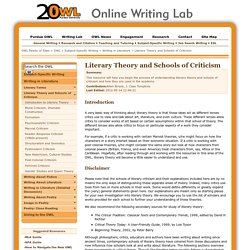
Contributors:Allen Brizee, J. Case TompkinsLast Edited: 2012-05-14 12:46:21 Introduction A very basic way of thinking about literary theory is that these ideas act as different lenses critics use to view and talk about art, literature, and even culture. 1.0 Intro to Critical Lenses - AP Literature with Mr. Wayland Cole, Colchester High School. 30738_analysis.pdf. Hero's journey. "A Practical Guide to Joseph Cambell’s The Hero with a Thousand Faces" by Christopher Vogler © 1985 “There are only two or three human stories, and they go on repeating themselves as fiercely as if they had never happened before.”
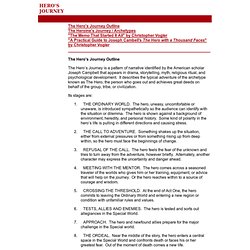
In the long run, one of the most influential books of the 20th century may turn out to be Joseph Campbell’s THE HERO WITH A THOUSAND FACES. The book and the ideas in it are having a major impact on writing and story-telling, but above all on movie-making. Filmmakers like John Boorman, George Miller, Steven Spielberg, George Lucas, and Francis Coppola owe their successes in part to the ageless patterns that Joseph Campbell identifies in the book.
The ideas Campbell presents in this and other books are an excellent set of analytical tools. With them you can almost always determine what’s wrong with a story that’s floundering; and you can find a better solution almost any story problem by examining the pattern laid out in the book. There’s nothing new in the book. “On Fairy-Stories” by J. R. R. Tolkien. Original location of this text Russian translation by V.
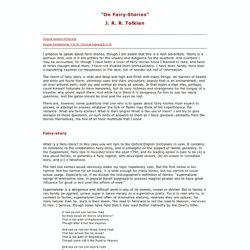
A. M. / Русский перевод В. А. М. I propose to speak about fairy-stories, though I am aware that this is a rash adventure. The realm of fairy-story is wide and deep and high and filled with many things: all manner of beasts and birds are found there; shoreless seas and stars uncounted; beauty that is an enchantment, and an ever-present peril; both joy and sorrow as sharp as swords. There are, however, some questions that one who is to speak about fairy-stories must expect to answer, or attempt to answer, whatever the folk of Faërie may think of his impertinence.
Fairy Tales. Mythology. It's All an Allusion: Identifying Allusions, in Literature and in Life. Overview | What is an allusion?

How often do you spot them, whether in your reading, in pop culture, in advertising or anywhere else? In this lesson, students read a Book Review essay about allusions in literature, take a quiz in which they identify allusions made in New York Times articles and headlines, then choose from a variety of activities to go deeper. Materials | Computers with Internet access and printing capability. Warm-Up | Ask students to define “allusion.” Check that they understand it as a “brief, usually indirect reference to another place, event” or to words spoken by or that depict a person or fictional character. Then, lead a discussion about the pros and cons of making allusions. End by turning the tables on yourself and your colleagues, having students ask you to explain allusions to things that most in their peer group will understand immediately but might not be so clear to those being asked. Related | In the essay “Grand Allusion,” Elizabeth D. Related resources: How to Mark a Book.
Archetypalcrit. The Hero Journey. Introduction to Modern Literary Theory. Psychoanalytic Criticism The application of specific psychological principles (particularly those of Sigmund Freud and Jacques Lacan [zhawk lawk-KAWN]) to the study of literature.
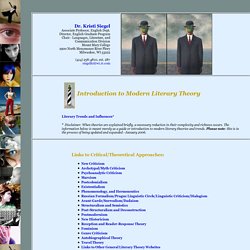
Psychoanalytic criticism may focus on the writer's psyche, the study of the creative process, the study of psychological types and principles present within works of literature, or the effects of literature upon its readers (Wellek and Warren, p. 81). VirtuaLit: Critical Approaches. Literary Criticism on the Internet. How to Do a Close Reading. The process of writing an essay usually begins with the close reading of a text.
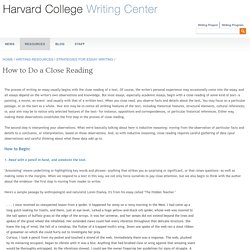
Of course, the writer's personal experience may occasionally come into the essay, and all essays depend on the writer's own observations and knowledge. But most essays, especially academic essays, begin with a close reading of some kind of text—a painting, a movie, an event—and usually with that of a written text. When you close read, you observe facts and details about the text. You may focus on a particular passage, or on the text as a whole. Your aim may be to notice all striking features of the text, including rhetorical features, structural elements, cultural references; or, your aim may be to notice only selected features of the text—for instance, oppositions and correspondences, or particular historical references.
The second step is interpreting your observations. How to Begin: 1. Here's a sample passage by anthropologist and naturalist Loren Eiseley. 2. What do we notice in the previous passage?